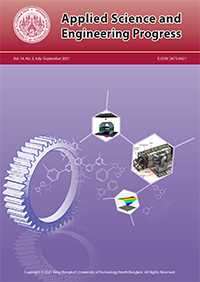The Influence of Vertical Centrifugal Casting on Nickel Aluminum Bronze Alloy for Using in the Royal Thai Navy
Main Article Content
Abstract
This research presents a guideline for forming nickel aluminum bronze or NAB workpieces in better mechanical properties for use in the Royal Thai Navy. In the past, NAB workpieces were formed by static casting and then were used in seawater condition, and it was found that the deterioration and low lifespan was a result of cavitation corrosion. Therefore, the analysis can be made that the mechanical properties are inappropriate for use in seawater conditions. This research discusses the advantages of the vertical centrifugal casting method on the static casting regarding the specimen’s hardness value. Therefore, the objective of this research is to study the influence of vertical centrifugal casting on hardness of NAB specimens using experimental design to determine appropriate conditions for NAB specimen’s hardness. The appropriate level of the mould speed is 483.8384 rounds per minute and the radius from centre of rotation is the 100 mm, and the result of the appropriate factors is 177.3542 VH as a maximum hardness. The regression equation from this research can also be used to form other appropriate mould speeds for other size of workpieces.
Article Details
References
[2] S. Sriintharasut, B. Poopat, and I. Phung-on, “The effect of different types of welding current on the characteristics of nickel aluminum bronze using gas metal arc welding,” Material Today, vol. 5, no. 3, pp. 9535–9542, 2018.
[3] W. Boonyatarogul, Pump and Pumping System. Bangkok, Thailand: Kasetsart University Press, 1986 (in Thai).
[4] Standard Specification for Aluminum-Bronze Sand Castings, ASTM B148-97, 2009.
[5] J. Anantapong, V. Uthaisangsuk, S. Suranuntchai, and A. Manonukul, “Effect of hot working on micro structure evolution of as-cast nickel aluminum bronze alloy,” Materials and Design, vol. 60, pp. 233–243, 2014.
[6] J. Wannasin, Metal Casting for Engineering. Bangkok, Thailand: Prince of Songkla University Press, 2010 (in Thai).
[7] D. C. Mongomery, Design and Analysis of Experiments, 6th ed. New Jersey: John Wiley & Sons, Inc., 2005.
[8] W. Mingsakul, C. Usadornsak, N. Tuntitippawan, and A. Kengpol, “Reducing of scrap in anodization process: A case study in a cosmetic packaging industry,” Applied Science and Engineering Progress, vol. 13, no. 1, pp. 67–75, 2020.
[9] P. Chutima, Engineering Design of Experiment. Bangkok, Thailand: Chulalongkorn University Press, 2002 (in Thai).
[10] C. Maicharoen, “The productivity improvement in a rice bran refining process with the experimental design case study: A refinery of rice bran,” M.S. thesis, Faculty of Engineering, King Mongkut,s University of technology North Bangkok, Bangkok, Thailand, 2003 (in Thai).
[11] S. Tuammee, “Defact reduction in plastic sheet process by applying the design of experiments a company case study in plastic industry,” M.S. thesis, Faculty of Engineering, King Mongkut,s University of Technology North Bangkok, Bangkok, Thailand, 2007 (in Thai).


